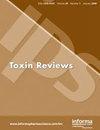印度旁遮普邦Ferozepur区农业土壤中潜在有毒元素造成的人类健康风险
IF 2.4
4区 医学
Q2 TOXICOLOGY
引用次数: 0
摘要
摘要本文研究了砷、镉、铬、钴、铜、铁、铅、锰、镍、铀和锌对土壤的污染;以及相关的人类健康风险在旁遮普邦Ferozepur区的30个农业点进行了评估。90%以上的土壤样品具有较高的氯化物、钠和钾含量。100%、76.67%、76.67%和66.67%的样品中的镉、砷、锌和铅超过了其安全限值(mg/kg;分别为0.06、20、50和10)。单个/多元素指数表明土壤中PTEs污染程度高,生态风险低至相当大。主成分PCI和PCII分别贡献了44.748%和30.476%的数据方差。使用聚类分析将土壤中的PTEs分为两类(I:Cd、U、Co、Pb、Ni、Cr、As、Cu、Zn和Mn;II:Fe),表明了地质成因和人为成因。还评估了通过皮肤接触、吸入和摄入PTE引起的健康风险。通过As暴露,发现儿童极易产生非癌症健康风险(平均危险指数=1.30),主要通过摄入途径。通过As(7.52E-05)和Cr(9.17E-06)暴露,主要通过摄入,对居民构成了较高的癌症总风险。生物修复和有效处置固体和液体废物可以减少研究区域的土壤污染。本文章由计算机程序翻译,如有差异,请以英文原文为准。
Human health risks in Ferozepur District, Punjab, India due to potentially toxic elements in agricultural soils
Abstract In the present study, soil contamination by arsenic, cadmium, chromium, cobalt, copper, iron, lead, manganese, nickel, uranium and zinc; and associated human health risks were assessed at 30 agricultural sites in Ferozepur District, Punjab. Above 90% soil samples had high content of chloride, sodium and potassium. Cadmium, arsenic, zinc and lead in 100%, 76.67%, 76.67% and 66.67% samples exceeded their safe limits (mg/kg; 0.06, 20, 50 and 10, respectively). Individual/multi-elemental indices indicated high PTEs contamination in soils posing low to considerable ecological risk. Principal components PCI and PCII contributed 44.748% and 30.476% variance in data, respectively. PTEs in soils were classified in two categories using cluster analysis (I: Cd, U, Co, Pb, Ni, Cr, As, Cu, Zn and Mn; II: Fe), indicating both geogenic and anthropogenic origins. Health risks due to PTE exposure via dermal contact, inhalation and ingestion were also assessed. Children were found to be highly prone to non-cancer health risk (mean hazard index = 1.30) by As exposure, mainly via ingestion pathway. High total cancer risk was posed to residents via As (7.52E-05) and Cr (9.17E-06) exposure, primarily through ingestion. Bioremediation and efficient disposal of solid and liquid wastes may reduce soil contamination in the study area.
求助全文
通过发布文献求助,成功后即可免费获取论文全文。
去求助
来源期刊

Toxin Reviews
医学-毒理学
CiteScore
6.80
自引率
0.00%
发文量
36
审稿时长
>12 weeks
期刊介绍:
Toxin Reviews provides an international forum for publishing state-of-the-art reviews and guest-edited single topic special issues covering the multidisciplinary research in the area of toxins derived from animals, plants and microorganisms. Our aim is to publish reviews that are of broad interest and importance to the toxinology as well as other life science communities. Toxin Reviews aims to encourage scientists to highlight the contribution of toxins as research tools in deciphering molecular and cellular mechanisms, and as prototypes of therapeutic agents. Reviews should emphasize the role of toxins in enhancing our fundamental understanding of life sciences, protein chemistry, structural biology, pharmacology, clinical toxinology and evolution. Prominence will be given to reviews that propose new ideas or approaches and further the knowledge of toxinology.
 求助内容:
求助内容: 应助结果提醒方式:
应助结果提醒方式:


